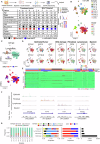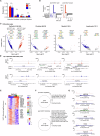The chromatin landscape of high-grade serous ovarian cancer metastasis identifies regulatory drivers in post-chemotherapy residual tumour cells
- PMID: 39341888
- PMCID: PMC11438996
- DOI: 10.1038/s42003-024-06909-9
The chromatin landscape of high-grade serous ovarian cancer metastasis identifies regulatory drivers in post-chemotherapy residual tumour cells
Abstract
Disease recurrence following chemotherapy is a major clinical challenge in ovarian cancer (OC), but little is known regarding how the tumour epigenome regulates transcriptional programs underpinning chemoresistance. We determine the single cell chromatin accessibility landscape of omental OC metastasis from treatment-naïve and neoadjuvant chemotherapy-treated patients and define the chromatin accessibility profiles of epithelial, fibroblast, myeloid and lymphoid cells. Epithelial tumour cells display open chromatin regions enriched with motifs for the oncogenic transcription factors MEIS and PBX. Post chemotherapy microenvironments show profound tumour heterogeneity and selection for cells with accessible chromatin enriched for TP53, TP63, TWIST1 and resistance-pathway-activating transcription factor binding motifs. An OC chemoresistant tumour subpopulation known to be present prior to treatment, and characterised by stress-associated gene expression, is enriched post chemotherapy. Nuclear receptors RORa, NR2F6 and HNF4G are uncovered as candidate transcriptional drivers of these cells whilst closure of binding sites for E2F2 and E2F4 indicate post-treated tumour having low proliferative capacity. Delineation of the gene regulatory landscape of ovarian cancer cells surviving chemotherapy treatment therefore reveals potential core transcriptional regulators of chemoresistance, suggesting novel therapeutic targets for improving clinical outcome.
© 2024. The Author(s).
Conflict of interest statement
The authors declare no competing interests.
Figures






Similar articles
-
Chromatin H3K27me3/H3K4me3 histone marks define gene sets in high-grade serous ovarian cancer that distinguish malignant, tumour-sustaining and chemo-resistant ovarian tumour cells.Oncogene. 2013 Sep 19;32(38):4586-92. doi: 10.1038/onc.2012.477. Epub 2012 Nov 5. Oncogene. 2013. PMID: 23128397
-
Cell surface CD55 traffics to the nucleus leading to cisplatin resistance and stemness by inducing PRC2 and H3K27 trimethylation on chromatin in ovarian cancer.Mol Cancer. 2024 Jun 10;23(1):121. doi: 10.1186/s12943-024-02028-5. Mol Cancer. 2024. PMID: 38853277 Free PMC article.
-
A distinct pre-existing inflammatory tumour microenvironment is associated with chemotherapy resistance in high-grade serous epithelial ovarian cancer.Br J Cancer. 2015 Mar 31;112(7):1215-22. doi: 10.1038/bjc.2015.81. Br J Cancer. 2015. PMID: 25826225 Free PMC article.
-
The role of distinct BRD4 isoforms and their contribution to high-grade serous ovarian carcinoma pathogenesis.Mol Cancer. 2021 Nov 10;20(1):145. doi: 10.1186/s12943-021-01424-5. Mol Cancer. 2021. PMID: 34758842 Free PMC article. Review.
-
New insight into NANOG: A novel therapeutic target for ovarian cancer (OC).Eur J Pharmacol. 2019 Jun 5;852:51-57. doi: 10.1016/j.ejphar.2019.03.003. Epub 2019 Mar 2. Eur J Pharmacol. 2019. PMID: 30831081 Review.
References
-
- Galluzzi, L. et al. Molecular mechanisms of cisplatin resistance. Oncogene31, 1869–1883 (2012). - PubMed
MeSH terms
Substances
Grants and funding
LinkOut - more resources
Full Text Sources
Medical
Molecular Biology Databases
Research Materials
Miscellaneous

